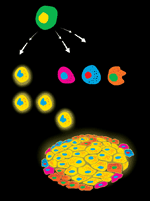
Last blog I talked about how I may have to be cloned to get my own embryonic stem (ES) cells. I was willing to deal with all of the associated ethical baggage because these sorts of cells would be so useful. They'll help cure many of my future ailments without my body rejecting these ES cells because they'll be made from my DNA.
This week a report has come out in Nature that may let me have my cake and eat it too (at least a few years from now). Scientists in Japan report that they can turn mouse skin cells into ES cells. And two other labs were able to repeat the result.
This is a really big deal. If we can get this to work in people, scientists can concentrate on finding cures. Instead of trying to find the money to do their research.
Two of the big opponents to ES cell research are the Catholic Church and the U.S. federal government. Neither is opposed to this line of research because it doesn't create and destroy a fetus.
This new procedure also eliminates some technical hurdles. For example, no one has actually successfully cloned a person. Now we won’t have to in order to make personalized ES cells.
